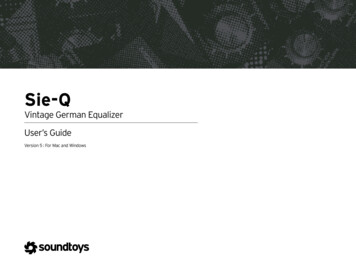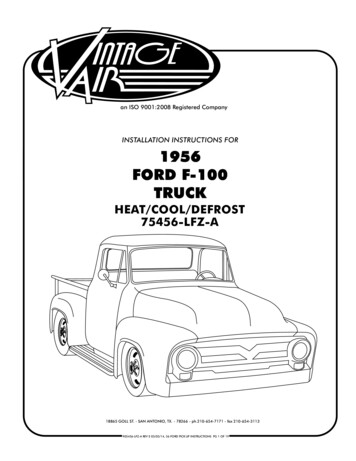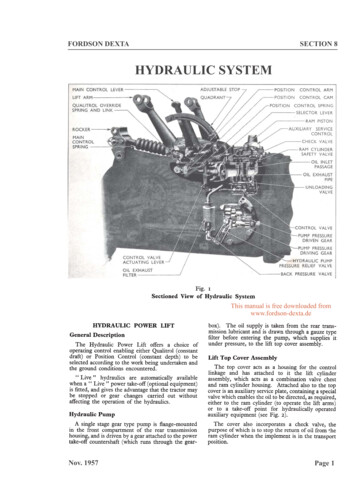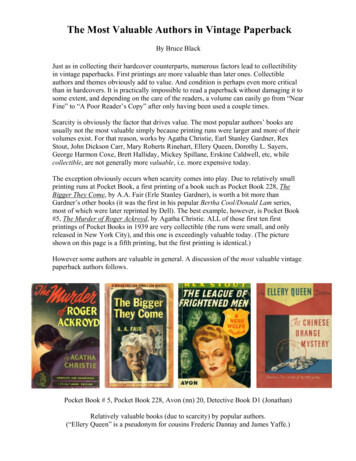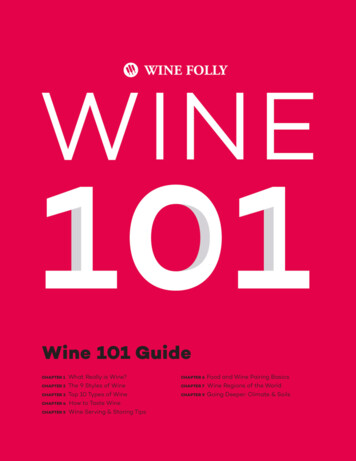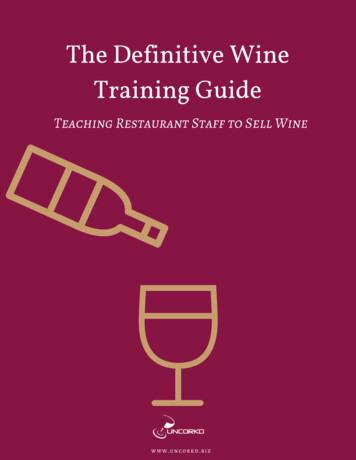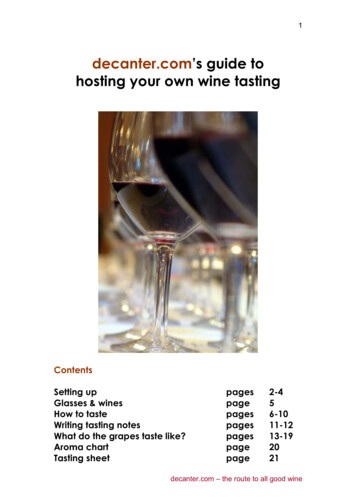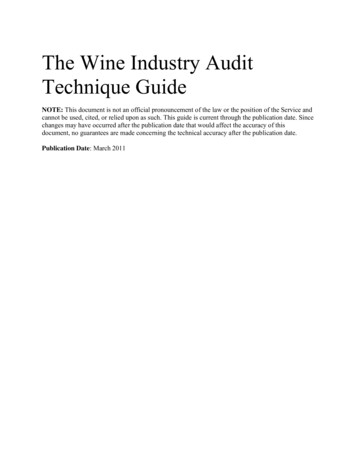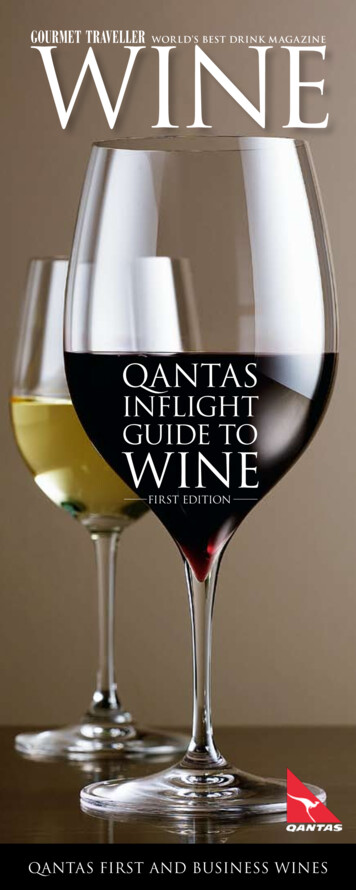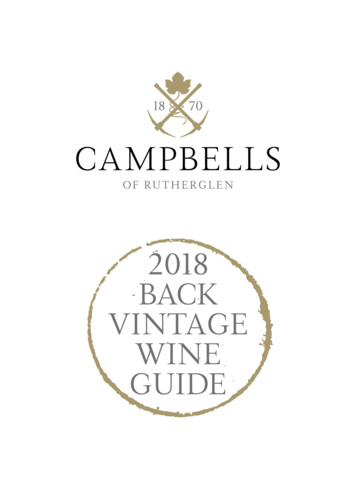
Transcription
2018BACKVINTAGEWINEGUIDE
2018 Back Vintage Wine GuideA unique feature of Campbells Wines is our practice of maintaining stocks of Back Vintage wines ideallysuited to cellaring, and holding on to these for re-release with the specific purpose of making theseBack Vintage Wines available at the peak of their development.Selected wines are released regularly to our Cellar Club members and at Cellar Door through our BackVintage Wines programme. Our 2018 Back Vintage Wine Review has been compiled to assist all winelovers in obtaining the maximum benefit and enjoyment of their cellared wines.Once every two years we convene an expert panel at the winery to taste and critically assess all availablewines from the past 20 years. This process enables us to determine appropriate release dates for ourBack Vintage Wines. It is also an opportunity for us to assess the development and future potential ofmost of the wines we have produced over the past 20 years.The information from our 2018 tasting has been compiled into this guide to assist you in your cellaringand enjoyment of Campbells wines.All wines are constantly developing and changing as they age and any guide is only useful for a limitedperiod. A tasting is essentially a snapshot of the development of a particular wine at a given point intime. From this snapshot, and previous experience with a wine or style, we make our assessment of itspotential to change in the bottle.You can use the specific wine information in this guide until late 2020 with confidence but beyond thatdate it will become increasingly less useful.Please feel free to contact us anytime with your enquiry on 1800 359 458 or emailsales@campbellswines.com.au. Our next guide will be released in late 2020.Best wishesMalcolm CampbellColin CampbellViticulturist Winemaker
Contents.When is a wine at its best? 4Transporting and storing wine 5-7In your car 5To freight or not to freight 5In your home 6Simple storage solutions 6Places to avoid leaving wine 7Screw caps and alternative closures 7Inspecting individual bottles for soundness 8Purchasing aged wines - buyers beware! 8Wine levels in bottles 8Leaking corks 8Serving Back Vintage Wines 9Colour 9-12Crust and sediments in wine 9Wine crystals (clear solids in wine) 9Mould on corks 9‘Cork’ taint (corked wine)10Decanting (opening wines prior to serving) 10Serving temperature 11Glass selection 11Food selection 12Tasting and appreciating wine 13-14Sight 13Smell 13Taste 14What is the flavour? 14Texture 14Balance 14Our winemaking philosophy 15Our vines and wines 16Our 2018 Back Vintage Wine review 17Tasting notes 17Cellaring potential 17Rating 172
Contents.Wines reviewed 18-39Riesling 18Pedro Ximenez 19Trebbiano 20Chardonnay 21Chardonnay - Limited Release 22Fiano - Limited Release 23Roussanne - Limited Release 24Marsanne Viognier - Limited Release 25Semillon - Limited Release 26Viognier - Limited Release 27Shiraz Durif 28Tempranillo - Limited Release 29Malbec - Limited Release 30The Sixties Block 31Petit Verdot - Limited Release 32Cabernet Sauvignon 33Cabernets - Limited Release 34Bobbie Burns Shiraz 35Rutherglen Durif - Limited Release 36The Brothers Shiraz 37The Barkly Durif 38Vintage Port 39Rutherglen Muscat and Rutherglen Topaque 403
When is a wine at its best?This is a very subjective issue and it depends on individual tastes.Wine can be likened to a piece of fruit in its development. Many fruits look ready to eat when theyare still some time from achieving full ripeness. Cherries, mangos, and peaches are some fruits that areoften picked prior to full development. If they are eaten in this state they are often high in acid, withsharp flavours, and not at their most enjoyable.Left to ripen their colours darken, acid levels become lower and their general appeal and taste is muchmore pleasant. Left too long past this point and they lose this attractive balance, begin to oxidize andeventually rot.Like fruit, many wines are sold prior to attaining their most harmonious mix of flavours and tastesensations.Young red wines have vibrant colour and strong fruit flavours, which add to their appeal, but they alsohave high levels of drying tannins, and often the delicate fruit flavours are masked by oak. Thesecharacters mellow over time and new and different characters emerge as a result of this process. If awine is kept too long this development becomes excessive and the wine will become progressively lessappealing.White wines also develop in the bottle and change character. Wood aged white wines will contain thesame oak tannins and flavours as red wines and these soften in the same manner.Aromatic white wines such as Riesling, and to a lesser extent Semillon, exhibit delicate fragrant aromasthat are appealing when young. If cellared for an extended period these aromas may decline in intensity,but the development of new aromas and flavours such as honey, cashew and buttered toast begin todevelop.Most wines, white or red, go through a period between one and three to five years from bottling whenthey seem to lose their lifted youthful aromas but have yet to develop their secondary aged flavours. Wedescribe such wines as ‘dumb’ or ‘sleeping’ as they display few lifted aromas. ‘Let sleeping dogs lie’ issafe advice in this instance. Hold on to sleepers for another two to three years, in most cases you will berewarded for your patience.Note: All wines tasted in this guide were cellared at the winery in temperature controlled conditions.The ambient temperature of our cellar does not change quickly and varies between 14 and 18 degreesthrough the course of the year. If your wines have been stored in warmer conditions they will developmore quickly. If kept in cooler conditions they may develop at a slower rate.4
Transporting and storing wineWinemakers take great care to ensure that the delicate flavours of their wines are protected andenhanced in order to present consumers with the best possible product. However once the wineleaves the winery the harmful influences of heat and rapid changes in temperature and light must becontrolled if it is to maintain best condition.Here are some tips to protect the flavour and quality when transporting and storing wine.In your carThis is perhaps the most dangerous environment for wine storage particularly during the warmermonths. The interior and boot of vehicles can reach oven like temperatures when parked in directsunlight.Such conditions can in effect ‘cook’ the wine, with the delicate fruit flavours that the winemaker hasstriven to preserve, soon turning bland and unpalatable. You may find with wines under cork that thepressure created by the expanding wine in the bottle pushes the cork above the rim of the bottle, andleakage can occur. With most wines now bottled under screwcap the effects of temperature can be nearimpossible to see, and only become evident when the wine is opened (often with great expectations!)some years later. It is a largely inexact science, and short term exposure to heat may have little or noeffect, but as a general rule it is best to transport your wine as close to ambient temperature as possible.If travelling in the warmer months always park your car in the shade. When you have made yourpurchases be sure to keep your wine in an enclosed carton, and cover with a blanket or sun visor tominimize the chances of heat damage. When you return home or to your accommodation move the wineinside immediately.To freight or not to freight?Pretty well all of Australia’s wine growing areas experience warm summers. If purchasing wines at CellarDoor over the warmer months consider having the wine freighted to lessen the chances of heat damage.Conscientious wineries will not send wines out when hot weather is expected, so it can be a small priceto pay for peace of mind. Often wineries will offer discount freight for orders of a dozen or more, orperhaps even freight your wine free of charge as with our Cellar Club members.When considering your delivery instructions ensure your wine will be shaded and protected fromsunlight and heat if you are not at home. Consider having your wine delivered to your workplace ifappropriate.5
Transporting and storing wineIn your homeIf you are storing or cellaring wine, ideal conditions are a dark, stable environment with mediumhumidity and a stable temperature range somewhere between 14 and 20 C, with the less variance thebetter. As a very general rule wine stored at the upper end of this range will develop more quickly, withwines stored at or near the lower limit ageing slowly.An underground cellar is both romantic and practical for wine storage. Unfortunately, most homes donot have one! As a result most wine ends up being stored in the living quarters. This need not be toodetrimental to the wine if care is taken in the choice of location.Simple storage solutionsIt is possible to maintain a functioning ‘cellar’ in the home without going to huge expense; one justneeds to be a little innovative.Begin by selecting a site in the house that maintains the most stable year round temperature. A centralroom or cupboard with no external walls is ideal. An understorey garage is another good option. Investin a double bulb thermometer and do a few trials to find the best spot.If possible store your wines in their original cartons. This acts as another form of insulation, and alsokeeps the light out. Purpose made polystyrene cartons available from most good wine stores are also agreat option.Wines under cork should be stored on their side to prevent the cork from drying out. Wines underscrewcap may be stored upright or on their sides. Do be careful to ensure there is no pressure on thescrewcap closure so the seal is not inadvertently damaged.Recent years have seen an explosion in the number of temperature controlled wine fridges on themarket. Such cabinets are available in a huge range of shapes, sizes and capacities, and competitionin this sector means prices are far more reasonable than they were just a few years ago. Most majordepartment stores now offer a range, though for the best advice a specialist wine-store is a good placeto start. Our only recommendation would be to purchase the largest one affordable within your pricerange, as the collection inevitably grows. If space is a factor all capital cities and many regional centreshave businesses offering professional storage facilities. Prices vary so be sure to shop around.6
Transporting and storing winePlaces to avoid leaving wine Detached garages. These are usually unlined and subject to huge temperature variation. Living rooms. Wine racks in living rooms are subject to light and higher temperatures. Suitable for‘drink now’ wines, but not long term ageing. Kitchens. People often place wine racks on top of refrigerators in kitchens. This is the worst possibleenvironment with heat from the cooling element a factor. Avoid at all costs.Screwcaps and alternative closuresOver the past decade there have been a number of alternatives to cork developed, but most producersseem to have settled on cork or screwcap as their closure of choice. We believe neither closure ispreferable in every instance, with both having redeeming and negative qualities. Needless to say givenour focus on producing long lived Back Vintage Wines this is an issue we take very seriously.Choosing the correct closure for a particular wine can be a difficult decision as there is a lot ofconflicting ‘evidence’ available. At Campbells we initiated a series of trials a number of years ago to findout what closure works best for our wines.We have now trasitioned to screwcap closures on all of our wines. The result from our own researchand experience with closures indicate screwcap is the most sound closure available at this point intime. Given our Back Vintage Guide does include wine bottles under cork, we felt it best to includeinformation related to cork wine closure.7
Inspecting individual bottles for soundnessPurchasing aged wines – buyer beware!‘There are no good old wines just good old bottles’ - AnonWe enjoy being able to offer Back Vintage Wines for tasting and sale at our Cellar Door becausewe know that these wines have been looked after for the duration of their lives in our temperaturecontrolled cellars. But purchasing aged wines from auction or retail can be fraught with danger. Hereare a few simple rules to follow that will hopefully help you to avoid disappointment at the dinner table. Visually inspect fill levels to ensure that the wine is sound. An ‘ullage’ in the neck of thebottle increases the likelihood of the wine being oxidized. Colour can also be an indication, especially with older white wines. It is best to pass overwines that look excessively dull or dark. The label can also tell a story. If the label is torn or faded it may be an indication ofpoor storage conditions. Check the capsule to ensure no wine has leaked through the cork. If under screwcap checkto see that the cap has not been knocked or dented in any way, as this can break the sealand allow ingress of oxygen into the wine.Wine levels in bottlesA bottle’s fill level, or ullage, is a good barometer of a wine’s health, its age and the manner in whichit was stored. Ullage is caused by evaporation of wine through the cork, or a telltale leak through anillfitting or damaged screwcap, and generally indicates that some oxidation has taken place. A certainamount of ullage is acceptable in an older wine; indeed a wine may still be sound with an ullage level offour centimetres or more. Often the only way to discern the effect on the wine is to taste it. Young wines(those less than 10 years) should appear relatively unchanged.Leaking CorksEvidence of a small leakage may not necessarily mean spoilt wine. A bottle may leak because it wasexposed to a high temperature at some stage or lower air pressure such as travelling at high altitude.These influences may cause some leakage but no damage. Additionally some corks take a little time toseal perfectly and may allow some wine to leak initially.8
Serving Back Vintage WinesGeneral advice for the assessment and enjoyment of aged wines is as follows:ColourColour can be a great indication of a wine’s stage of development.White wines tend to deepen with age as they slowly oxidize, with clear or greenish hues giving way toa deeper golden colour, and in time a faded or brownish colour as the wine becomes over- developed(much like a piece of fruit).A. Young white wineB. Mature white wineC. Oxidized wine,likely to beunpalatableA. Young red wineB. Mature red wineC. Oxidized wine,likely to beunpalatableRed wines can be near opaque on release, and it is only by holding it against a white background thatyou can pick up the colour at the rim of the wine. In time the colour begins to fade, and the wine canbecome more tawny and in time also picks up a brown edge.Crust and sediments in winesAll wines contain grape solids. The size and quantity of these grape solids can vary greatly from wineto wine. The vast majority of white wines commercially available today undergo fine filtration, and thatbeing the case it is rare that a crust or sediment will form.However with red wines many winemakers adopt the practice of minimal filtration, arguing that thesenatural grape solids contain colour and flavour. In a young red such solids may be imperceptible as theyare still in suspension in the wine. Over time these solids precipitate out of suspension and can formas a crust on the side of the bottle, or sediment in the bottom of a bottle. These deposits are totallyharmless, and just a bi-product of the natural process of winemaking. With such wines it is advisable tohandle the wine very gently to avoid stirring the sediment back up into the wine, and carefully decant itprior to serving.Wine crystals (clear solids in the wine)With temperature change the ability of the wine to hold dissolved tartaric acid changes and some of thisacid can form as solid tartrate crystals. In white wine they sometimes appear like small crystals floatingin the wine. They are totally harmless and are not detrimental to the wine in any way. As the winewarms they may disappear.Mould on corksMould growing on the cork or under the capsule of a wine is not the cause of cork taint. This mayindicate that a small amount of wine has leaked at some stage, or the wine has been exposed toparticularly humid conditions. This mould on the cork will have no discernable affect on the wine.9
Serving Back Vintage Wines (cont.)‘Cork’ taint (corked wines)It is important to be able to recognize cork taint in wine. A ‘corked’ wine is caused by the presence inthe cork of an undesirable compound known as tri-chloro-anisole, or TCA for short. TCA is a mouldspore that occurs naturally in cork in infinitesimally small amounts, and is totally undetectable to thehuman eye.The effect TCA has on a wine can vary. A wine can be anything from mildly corked, to severely corked.A corked wine will generally display aromas and flavours such as damp cardboard, or musty wet hessian.Often fruit characters will be ‘stripped’, and the wine will taste flat and lifeless on the palate. TCAaffected wines are in no way harmful to consume and indeed many are consumed unknowingly.It is important not to immediately dismiss any wine displaying ‘odd aromas’ as ‘corked’. Odd smells,known in the industry as ‘bottle stink’, will often develop in a wine over time, and can be cleared byallowing the wine to ‘breathe’ or by decanting for a short period of time.Decanting (opening wines prior to serving)Allowing a wine to ‘breathe’ prior to consumption is a much misunderstood component of enjoying finewine, and as with most things related to the enjoyment of wine it can be an inexact science.Allowing a wine to ‘breathe’ is the process of opening a bottle and allowing the wine to come intocontact with oxygen in the air. This commences with pulling the cork or unscrewing the cap. The effectit has on a wine can be minimal as so little surface area of the wine actually comes into contact withoxygen. Our advice would be to have a decanter on hand at home (or ask for one in good restaurants).Decanting is often thought of as something one does just for older wines, when in fact it is youngwines that can benefit most. Poured directly from the bottle, a young wine may appear closed and hardstructured. Bringing a young wine into contact with oxygen can assist in softening the wine’s youthfulbite and promoting fruit character and more complex elements in the wine. Decanting a young redwine, 1-2 hours or more prior to serving is a good rule of thumb.Aged wines need to be treated in a different manner. A wine ageing or developing in bottle is in partthe reaction that takes place to the presence of oxygen. This may be due to a very small ingress ofoxygen through the closure, or a reaction with dissolved oxygen present in the wine since bottling.As an aged wine has had the opportunity to react to the presence of oxygen over a number of years inbottle, it does not always need a great deal of time in the decanter. Often 15-30 minutes is enough tosee a marked difference. Decanting also helps to remove ‘bottle stink’, a term used for the odd smellthat aged red wines can develop as a result of reactions occurring over time in the bottle. Alternativelytry pouring the wine from glass to glass several times to aerate it and the smell will dissipate. The otherbenefit of decanting an aged wine is that one can carefully pour the wine into the decanter and retainany sediment in the bottle.Decanting a white wine (especially a fuller bodied or oak aged white wine) is not unheard of, though itis generally more related to reds. The enjoyment of white wines can be influenced to a greater degreeby temperature.10
Serving Back Vintage Wines cont.Serving temperatureThe correct serving temperature is a crucial, though often overlooked consideration when enjoyingwine. What may be a perfectly enjoyable wine will appear hard and unyielding if served too cold, or hotand astringent if served too warm. This factor becomes more important as wines age.The attraction of mature wines is the development of complex flavours. However these tend to bemore subtle nuances, and many components are lost if the wine is served at the wrong temperature.- White winesServe mature white wines warmer than you might serve a younger wine, as this allows the moresubtle aromas to become more obvious. Serve mature white wines around 12 C, cold but notchilled.Sparkling wine and young unwooded whites such as Riesling or Gewurztraminer will be mostappealing at 8-9 C, whereas more full-bodied wood aged whites such as Chardonnay or Viognierwill be better at 10-12 C.- Red winesMost red wines should be served around 16-18 C, or a touch below room temperature. Pinot Noirand lighter reds are better at the lower end of the range, with Shiraz, Durif and other full bodiedstyles at the upper end. You can chill a red wine for 10-15 minutes or so prior to serving ifnecessary. If it is a little too cool on opening it will soon warm.- Muscat & TopaqueTraditionally viewed as a winter warmer and served at room temperature (approximately 18 C).Alternatively, Rutherglen Muscats and Topaques are just as delicious in summer served chilleddirectly from the fridge, or splashed over a handful of ice cubes.Glass selectionCorrect glassware is equally important and like temperature is often overlooked. Speaking generally thecorrect glass will feel light and balanced in your hand. A tulip shape assists in capturing and directingaromatics, whilst a fine rim helps direct the wine on to your mid palate.Avoid glasses with patterns, chunky rims and other such embellishments. They may look attractive onthe dinner table, but do nothing to enhance the enjoyment of your wine.Never serve a fortified wine in a small glass. These magnificent old wines require a generous bowl toallow the complex flavours of age to be released.At Cellar Door we serve our wines in Riedel; the world’s finest crystal glassware. Riedel produce a rangeof varietal and style specific glasses that enhance each variety’s individual attributes. Our Riedel tastingglasses are available for purchase at the winery.11
Serving Back Vintage Wines cont.Food selectionIt is often said that no great meal is complete without a glass of wine, and it could just as easily work theother way. A great meal can reveal complexities and subtle flavours in a wine that were otherwise notapparent.Many of the food and wine matching ‘rules’ that we grew up with have come to be null and void inmore recent times as we have come to embrace so many different cuisines and of course so manydifferent wine styles from around the world. Experimenting with different food and wine combinationscan be a lot of fun and yield some surprising results, so we tend not to be too particular in ourrecommendations.That said there are some good general guidelines to work within when serving aged wines. Older whitewines often build palate weight and texture with time in bottle, but lose acid. This being the case theycan pair well with slightly richer dishes such as white meats, game such as rabbit or homemade pasta.Seafood with cream based sauces can also be an ideal match for an older Riesling or Semillon.Older red wines pair best with subtle complex dishes without any domineering flavours. Slow cookedbeef and lamb dishes are ideal, and duck can be an incredibly versatile food match. Char-grilled andheavily marinated meats are generally better with younger red wines, as the strong flavours in the foodcan tend to dominate the subtleties of the older red wine. Similarly, foods with chilli or excessive spicewill quickly overpower an aged wine. In this instance look for a young wine (red or white) with a littleresidual sweetness to counter the heat of the dish.12
Tasting and appreciating wineTake your time when savouring a wine to fully appreciate the balance, taste and flavours.There are four senses we use when combining food or drink. These are sight, when visually assessinga wine, smell, detected by our nose, taste, detected by our tongue, and texture, detected by our mouthand tongue.Sight is a factor in wine appreciation and can tell you much about a wine prior to tasting it. Smell isperhaps the most important sense. Being able to detect different aromas, and pick attributes frompossible faults is a key part of enjoying fine wine. We smell aromas when we sniff wine from the glass.We refer to these same smells as flavours when they rise internally to our nasal passages from winewarming in our mouth. Wines contain over 200 compounds that react at ambient temperature, creatingpotentially 200 different aromas.Our tongue detects taste. There are just four tastes, sweetness (sugar), sourness (acid), bitterness andsaltiness. The Japanese also have a term, umami, which refers to a savoury flavor, and that is certainly arelevant flavor in wine appreciation as well.In addition we also feel several sensations when wine touches parts of our mouths. Viscosity is ameasure of the weight of the wine in the mouth, and is most evident in the contrast between a youngRiesling and rich full-bodied red. High levels of alcohol in a wine will appear as a hot sensation in ourmouths. Our mouths also detect astringency; the puckering sensation caused by tannins and relatedcompounds.SightExperienced tasters can glean a lot from visually assessing a wine, and it is deemed an important factorby judges in wine shows. Colour can give an indication of the wine’s body, and expected depth offlavour. It also gives clues as to a wine’s age, with fading or browning wines likely to be well developed.Swirling the wine and seeing how it clings to the glass will also show the viscosity of the wine.SmellThere are several groups of aromas present in wines and the presence of these varies considerablydepending on the age and nature of individual wines.Firstly there are the primary fruit aromas present in the grapes that may be enhanced by fermentation.These are caused by the presence of flavour compounds and we recognise and describe these from ourmemory bank. Raspberries, cherries, black currants, asparagus, lemon and pine needle are all examplesthat have very distinctive and strong aromas/flavours. The compounds that cause these aromas are alsopresent in different grapes.In addition, there are the aromas imparted by the winemaking processes such as oak maturation.As wines age, these primary fruit flavours begin to decline and the complex compounds in the winedevelop and interact to form a whole new range of aromas that we associate with bottle maturation. Awine is said to be at its peak with regard to aroma and flavour when the complex numbers of decliningand developing odours form the most harmonious and appealing mix.13
Tasting and appreciating wineTasteOur tongue is a complex piece of equipment and it possesses numerous papillaespread across the upper surface, each containing several hundred taste buds.These detect levels of sweetness, saltiness, sourness and bitterness. Sweetness(sugar) is detected towards the front of the tongue, sourness (acid) along thefront to middle sides of the tongue and bitterness on the centre back of thetongue. There is generally no detectable salt in wines and bitterness isgenerally at low levels in wines.What is that flavour?Often people at Cellar Door will comment that they can detect certain flavours in wines, but cannotaccurately pick what they are. Quite simply it is a matter of practice, and gaining an understanding ofhow one’s palate works. Wine tasting is a highly subjective art, and you will find people’s palates arevery seldom perfectly aligned.If you are interested in expanding your tasting vocabulary, aids such as the wine tasting and aromawheel, and the essential tasting guide are readily available from good wine stores, or contact the wineryfor more information.TextureTexture is an unheralded concept in wine tasting. We spend much time describing aromas and flavoursthat we can smell and taste in wine, but it is never quite as easy describing the textural sensation takingplace in our mouth.Most components of wine can impact on texture in some way. Tannin is a natural compound presentin most dry wines (more prevalent in red wines) and is extracted from the grape skins and seedsduring fermentation. Tannins are responsible for the slightly drying and occasionally mouth-puckeringsensation we have when we drink wine. They can be described as fine, silky, chewy, chalky, drying oreven raspy. Ideally they blend seamlessly into a wine as it ages.Oak also plays a factor in most red and many white wines. Heavily oaked wines can be more viscous,and have a slightly charry mouthfeel. Again, in balance, oak should add a pleasant structural andtextural element to an aged wine. Acid and alcohol are perhaps less obvious textural factors, but bothplay a part, and in excess can make a wine appear unbalanced.BalanceBalance is the interplay between the different elements present in a wine. For a wine to age well, fruitflavours, acid, tannin, alcohol, residual sugar (if present) and oak (if present) need to be in balance withno individual component overshadowing another. A wine with any of these characters in excess maywell be appealing when young, but is unlikely to age wel
The information from our 2018 tasting has been compiled into this guide to assist you in your cellaring and enjoyment of Campbells wines. All wines are constantly developing and changing as they age and any guide is only useful for a limited period. A tasting is essentially a snapshot of the development of a

